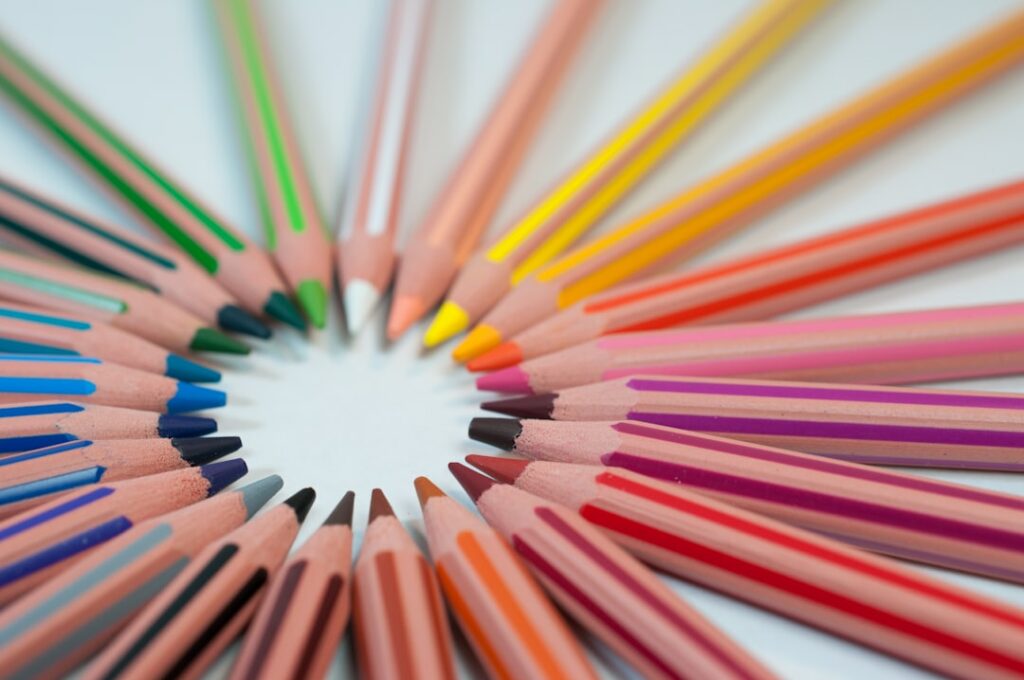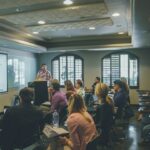Creativity exercises are valuable tools for artists and musicians to maintain their creative flow and overcome creative blocks. These exercises enable individuals to access their innate creativity, explore novel concepts, and expand their artistic boundaries. Incorporating creativity exercises into daily practice can help maintain inspiration and motivation for both visual artists and musicians.
Various techniques, including brainstorming and improvisation, can stimulate creativity and enhance artistic abilities. The benefits of creativity exercises extend beyond artists and musicians to other creative professionals, such as writers, designers, and dancers. These exercises can provide fresh perspectives, encourage innovation, and foster a mindset of exploration and experimentation.
Regular engagement in creativity exercises can lead to skill development, resolution of creative blocks, and the discovery of new forms of self-expression. Integrating creativity exercises into one’s routine can significantly impact an individual’s creative journey, whether for enhancing artistic practice or seeking inspiration.
Key Takeaways
- Creativity exercises are essential for artists and musicians to enhance their creative skills and overcome creative blocks.
- Brainstorming techniques such as mind mapping and word association can help artists and musicians generate new ideas and concepts.
- Improvisation exercises, such as free-form jam sessions for musicians, can help develop spontaneity and musical intuition.
- Visual inspiration exercises, such as observational drawing and color studies, can help artists develop their visual language and style.
- Collaborative creativity exercises, such as group improvisation and art collaborations, can foster teamwork and new perspectives.
- Mindfulness and meditation practices can help artists and musicians cultivate a clear and focused mind for creative work.
- Using constraints, such as time limits or material restrictions, can challenge artists and musicians to think outside the box and find innovative solutions.
Brainstorming Techniques for Artists and Musicians
Visualizing Ideas with Mind Mapping
One effective brainstorming technique is mind mapping, where you start with a central idea and branch out into related concepts, associations, and inspirations. This visual representation of ideas can help you make connections and uncover new directions for your artistic work.
Unleashing the Subconscious with Free Writing
Another popular brainstorming technique is free writing, where you set a timer and write continuously without stopping or censoring yourself. This can help you bypass your inner critic and tap into your subconscious mind, leading to unexpected and innovative ideas.
Collaborative Brainstorming for Artists and Musicians
For musicians, collaborative brainstorming sessions with bandmates or fellow musicians can be a powerful way to generate new musical concepts and compositions. By bouncing ideas off each other and building on each other’s contributions, musicians can create rich and dynamic musical arrangements. Visual artists can also benefit from collaborative brainstorming by engaging in group critique sessions or participating in art collectives where they can exchange ideas and receive feedback from their peers.
Breaking Through Creative Blocks
Ultimately, brainstorming techniques are versatile tools that can help artists and musicians break through creative blocks, expand their creative vision, and cultivate a spirit of open-minded exploration.
Improvisation Exercises for Musicians

Improvisation is a core skill for musicians, allowing them to spontaneously create music in the moment. Incorporating improvisation exercises into your musical practice can help you develop your musical vocabulary, enhance your listening skills, and cultivate a sense of musical freedom. One popular improvisation exercise is to play along with backing tracks or jam with other musicians, allowing you to explore different musical styles and experiment with new ideas in a supportive environment.
Another effective improvisation exercise is to set constraints for yourself, such as limiting the number of notes you can use or focusing on a specific scale or mode. This can push you to think outside the box and discover new musical possibilities within these constraints. For visual artists, improvisation exercises can involve working with different mediums or techniques outside of your comfort zone.
This could include experimenting with mixed media, creating art with found objects, or exploring abstract expressionism. By embracing spontaneity and letting go of preconceived notions, visual artists can tap into their intuition and create art that is raw, authentic, and emotionally charged. Ultimately, improvisation exercises for musicians and visual artists can help individuals break free from creative constraints, embrace uncertainty, and unleash their innate creativity in its purest form.
Visual Inspiration Exercises for Artists
Visual inspiration exercises are essential for artists to expand their visual vocabulary, refine their artistic style, and find new sources of inspiration. One effective visual inspiration exercise is to create a mood board or collage using images that resonate with you aesthetically or thematically. This can help you identify recurring motifs, color palettes, and visual elements that inspire you, providing a springboard for your own artistic exploration.
Another visual inspiration exercise is to study the work of other artists across different genres and time periods, allowing you to gain insights into their techniques, concepts, and creative processes. For musicians, visual inspiration exercises can involve creating soundscapes or musical compositions inspired by visual art or natural landscapes. By translating visual stimuli into musical expressions, musicians can expand their sonic palette and infuse their music with evocative imagery and emotional depth.
Visual artists can also benefit from incorporating music into their creative process by listening to different genres of music while working on their art or creating visual representations of musical compositions. By bridging the gap between visual art and music, artists can enrich their creative practice and explore new dimensions of artistic expression.
Collaborative Creativity Exercises for Artists and Musicians
Collaborative creativity exercises are valuable for artists and musicians to engage in collective exploration, exchange ideas, and create synergistic works of art. For musicians, collaborative creativity exercises can involve co-writing songs with other songwriters or composing music for interdisciplinary projects such as dance performances or multimedia installations. By collaborating with other musicians or artists from different disciplines, musicians can gain fresh perspectives, learn new techniques, and expand their creative network.
Visual artists can also benefit from collaborative creativity exercises by participating in group exhibitions, art residencies, or community art projects where they can collaborate with other artists and create collective artworks. Another collaborative creativity exercise for artists and musicians is to engage in improvisational jam sessions or live art performances where spontaneous creation takes center stage. By embracing the unpredictability of collaborative improvisation, artists and musicians can tap into the collective energy of the group and create art that transcends individual limitations.
Ultimately, collaborative creativity exercises can foster a sense of community, mutual support, and shared creative vision among artists and musicians, leading to innovative collaborations and boundary-pushing artistic endeavors.
Mindfulness and Meditation Practices for Creativity

Cultivating a State of Flow
Mindfulness practices such as deep breathing exercises, body scans, or mindful walking can help individuals ground themselves in the present moment, quiet the mental chatter, and access a state of flow where creativity can flourish. Meditation practices such as loving-kindness meditation or visualization meditation can help artists and musicians cultivate a sense of compassion, self-acceptance, and emotional resilience, providing a strong foundation for their creative endeavors.
Integrating Mindfulness into Musical Practice
For musicians, mindfulness and meditation practices can be integrated into their musical practice through mindful listening exercises or meditative playing techniques such as mantra repetition or drone-based improvisation. By approaching music with a meditative mindset, musicians can deepen their connection to the music, heighten their sensory perception, and access heightened states of musical expression.
Mindfulness in the Art-Making Process
Visual artists can also benefit from mindfulness and meditation practices by incorporating mindfulness into their art-making process through slow looking exercises or mindful mark-making techniques. By approaching art with a meditative awareness, visual artists can create art that is imbued with intentionality, presence, and emotional resonance.
Using Constraints to Spark Creativity
Using constraints as a catalyst for creativity is a powerful approach for artists and musicians to push past creative blocks, embrace limitations, and discover innovative solutions within defined parameters. For musicians, using constraints can involve setting limitations on instrumentation, time signatures, or harmonic structures when composing music. By imposing constraints on their musical compositions, musicians can challenge themselves to think outside the box, experiment with unconventional approaches, and create music that defies traditional conventions.
Visual artists can also benefit from using constraints by imposing limitations on color palettes, canvas sizes, or time-based challenges such as daily drawing prompts or weekly art challenges. Another effective way to use constraints to spark creativity is through the practice of found object art for visual artists or found sound composition for musicians. By repurposing everyday objects or environmental sounds into artistic expressions, artists and musicians can transform mundane materials into sources of creative inspiration.
Embracing constraints can also lead to unexpected breakthroughs in artistic expression by forcing individuals to think creatively within the confines of limitations. Ultimately, using constraints as a springboard for creativity can lead to innovative artistic outcomes that defy expectations and expand the boundaries of artistic possibility. In conclusion, creativity exercises are essential tools for artists and musicians to nurture their creative potential, overcome creative blocks, and expand their artistic horizons.
Whether it’s through brainstorming techniques, improvisation exercises, visual inspiration exercises, collaborative creativity exercises, mindfulness practices, or using constraints as a catalyst for creativity, there are numerous ways for artists and musicians to tap into their innate creativity and elevate their artistic practice. By incorporating these creativity exercises into their daily routine, artists and musicians can cultivate a mindset of exploration, experimentation, and open-mindedness that will propel them towards new artistic heights.
If you’re looking for more tips on enhancing your creativity, check out the blog section of Intelligences N’Hacks. They offer a variety of articles on different topics related to personal development and creativity, such as «How to Take Book Notes» (source). Their website is a great resource for artists and musicians looking to expand their creative abilities.
FAQs
What are creativity exercises for artists and musicians?
Creativity exercises for artists and musicians are activities or techniques designed to stimulate and enhance creative thinking, problem-solving, and artistic expression.
Why are creativity exercises important for artists and musicians?
Creativity exercises are important for artists and musicians as they help in overcoming creative blocks, generating new ideas, and expanding artistic skills and abilities.
What are some examples of creativity exercises for artists and musicians?
Examples of creativity exercises for artists and musicians include brainstorming sessions, improvisation, visual journaling, collaborative projects, and exploring different artistic mediums.
How do creativity exercises benefit artists and musicians?
Creativity exercises benefit artists and musicians by fostering innovation, enhancing artistic skills, promoting self-expression, and providing a means for personal and professional growth.
Can creativity exercises be used by artists and musicians of all levels?
Yes, creativity exercises can be used by artists and musicians of all levels, from beginners to experienced professionals, to enhance their creative abilities and artistic output.






